
The falx was a weapon with a curved blade that was sharp on the inside edge used by the Thracians and Dacians. The name was later applied to a siege hook used by the Romans.

The falx was a weapon with a curved blade that was sharp on the inside edge used by the Thracians and Dacians. The name was later applied to a siege hook used by the Romans.
Falx is a Latin word originally meaning 'sickle' but was later used to mean any of a number of tools that had a curved blade that was sharp on the inside edge like a sickle. Falx was thus also used to mean the weapon of the Thracians and Dacians, and the Roman siege hook.
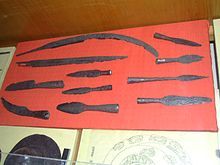
In Latin texts, the weapon was described as an ensis falcatus (whence falcata ) by Ovid in Metamorphose and as a falx supina by Juvenal in Satiriae.
The Dacian falx came in two sizes: one-handed and two-handed. The shorter variant was called sica [2] (sickle) in the Dacian language (Valerius Maximus, III, 2.12) with a blade length that varied but was usually around 16 inches (41 cm) long with a handle one-third longer than the blade. The two-handed falx was a polearm. It consisted of a 3-foot-long (0.91 m) wooden shaft with a long curved iron blade of nearly-equal length attached to the end. Archaeological evidence indicates that the one-handed falx was also used two-handed. [3]
The blade was sharpened only on the inside and was reputed to be devastatingly effective. However, it left its user vulnerable because, being a two-handed weapon, the warrior could not also make use of a shield. It may be imagined that the length of the two-handed falx allowed it to be wielded with great force, the point piercing helmets and the blade splitting shields – it was said to be capable of splitting a shield in two at a single blow. Alternatively, it might have been used as a hook, pulling away shields and cutting at vulnerable limbs, or striking the edge of a strong shield. The inward curving point was still able to pierce the armour or flesh of the target behind the shield, rendering even the most reinforced shields much less effective against a falx wielder.
Trajan's column is a monument to the emperor's conquest of Dacia. The massive base is covered with reliefs of trophies of Dacian weapons and includes several illustrations of the two-handed falx. The column itself has a helical frieze that tells the story of the Dacian wars. On the frieze, almost all the Dacians that are armed have shields and therefore cannot be using two-handed falx. The exact weapon of those few shown without shields cannot be determined with certainty. The frieze of Trajan's column also shows Dacians using smaller, sword-sized falx. However, this column is also largely stylized, with the sculptor believed to have worked from Trajan's now lost commentary and unlikely to have witnessed the events himself. A further problem is that most of the weapons on the monument were made of metal, which have since disappeared. [4]
The Adamclisi monument, built by Trajan to commemorate the Romans who lost their lives in the Dacian counterattack in Moesia, is thought to have been constructed by the soldiers who fought there, so it may be more accurate. This column shows four distinct types of falx, whereas Trajan's shows only one type that does not resemble any on the Adamclisi monument. Because of this, historians disagree on which depiction is correct, but it has been pointed out that if the Trajan's column falx are correct, then there would have been no need to modify Roman armour. [5] Both columns show the Dacians fighting with no armour apart from a shield, although some on the Adamclisi are wearing helmets. Some historians believe that armour was not depicted to differentiate Dacians from Romans, as both used the same style of shield. Other sources indicate that Dacians by this time had undergone Romanisation, used Roman military tactics, and sometimes wore Roman style scale armour. It is likely that the nobles at least wore armour and, combined with the falx, the Dacians would have been a formidable threat. [6]
Marcus Cornelius Fronto described the large gaping wounds that a falx inflicted, and experiments have shown that a blow from a falx easily penetrated the Romans' lorica segmentata , enough to incapacitate or kill a majority of opponents. These experiments also show that the falx was most efficient when targeting the head, shoulders, legs and especially the right (sword) arm, which was generally exposed. A legionary who had lost the use of his right arm became a serious liability to his unit in battle. [3]
During the conquest of Dacia by Trajan the Roman army adapted personal equipment while on campaign, and it seems likely that this was a response to this deadly weapon. Roman legionaries had transverse reinforcing iron straps applied to their helmets - it is clear that these are late modifications because they are roughly applied across existing embossed decoration. The legions also reintroduced the wearing of lorica hamata and lorica squamata for the Dacia campaign as both were more flexible than the newer segmentata armour which was able to distribute damage more widely. In addition, both these older armour styles had unique modifications, a row of pteruges was added to the sleeves, a double row of pteruges was added to the skirt and a heavily padded vestment was worn underneath them. Roman armour of the time left limbs unprotected; Trajan introduced the use of greaves and an arm protector ( manica ) for the right arm, which had previously been used only by gladiators, and which was never used again by soldiers once the Dacia campaign concluded. [7] [ contradictory ]
The Thracians also made use of the falx. They also used the rhomphaia , a weapon very similar to the two-handed falx but less curved.
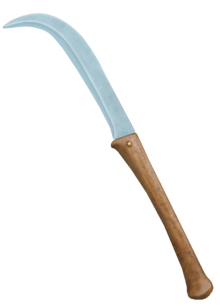
The two-handed falx is clearly related to the Thracian rhomphaia. It is a derivative of both the sword and the spear, having evolved from a spear to a polearm before becoming more dramatically curved to facilitate a superior cutting action.[ citation needed ] This drastic curve rendered the falx a purely offensive weapon to be used against a broken or routing force.[ citation needed ] Typically, an enemy would be broken by a sustained hail of missile fire from javelin, dart, bow, sling, and stone throwing troops before being chased down and cut to pieces by the falx wielders.[ citation needed ]
The ancestor of the two-handed falx may have been a farming implement used as an improvised weapon, in a manner analogous to the bill-guisarme.[ citation needed ] The single-handed falx might have been inspired by the sickle, although agricultural sickles of the time were typically quite small – no more than 30 cm or so in length.[ citation needed ]
At the time of the Dacian wars, producing a long, sharp blade was technically challenging.[ citation needed ] As such, it might be that the larger two-handed falx was a high-status weapon and used only by the best warriors.[ citation needed ]
Similarly, there are the sica and the rhomphaia. The sica is a much smaller variation, some with very dramatic curves or bends. The rhomphaia is often larger and used with two hands, though there were some one handed ones.

The lorica segmentata, also called lorica lamminata, or banded armour is a type of personal armour that was used by soldiers of the Roman army, consisting of metal strips fashioned into circular bands, fastened to internal leather straps.
This is a list of types of swords.

Sarmizegetusa Regia was the capital and the most important military, religious and political centre of the Dacians before the wars with the Roman Empire. Built on top of a 1200 m high mountain, the fortress, consisting of six citadels, was the core of a strategic and defensive system in the Orăștie Mountains.

The Dacians were the ancient Indo-European inhabitants of the cultural region of Dacia, located in the area near the Carpathian Mountains and west of the Black Sea. They are often considered a subgroup of the Thracians. This area includes mainly the present-day countries of Romania and Moldova, as well as parts of Ukraine, Eastern Serbia, Northern Bulgaria, Slovakia, Hungary and Southern Poland. The Dacians and the related Getae spoke the Dacian language, which has a debated relationship with the neighbouring Thracian language and may be a subgroup of it. Dacians were somewhat culturally influenced by the neighbouring Scythians and by the Celtic invaders of the 4th century BC.

Decebalus, sometimes referred to as Diurpaneus, was the last Dacian king. He is famous for fighting three wars, with varying success, against the Roman Empire under two emperors. After raiding south across the Danube, he defeated a Roman invasion in the reign of Domitian, securing a period of independence during which Decebalus consolidated his rule.

Burebista was the king of the Getae and Dacian tribes from 82/61 BC to 45/44 BC. He was the first king who successfully unified the tribes of the Dacian kingdom, which comprised the area located between the Danube, Tisza, and Dniester rivers, and modern day Romania and Moldova. In the 7th and 6th centuries BC it became home to the Thracian peoples, including the Getae and the Dacians. From the 4th century to the middle of the 2nd century BC the Dacian peoples were influenced by La Tène Celts who brought new technologies with them into Dacia. Sometime in the 2nd century BC, the Dacians expelled the Celts from their lands. Dacians often warred with neighbouring tribes, but the relative isolation of the Dacian peoples in the Carpathian Mountains allowed them to survive and even to thrive. By the 1st century BC the Dacians had become the dominant power.

The Tropaeum Traiani or Trajan's Trophy lies 1.4 km northeast of the Roman city of Civitas Tropaensium. It was built in AD 109 in then Moesia Inferior, to commemorate Roman Emperor Trajan's victory over the Dacians in 106, including the victory at the Battle of Adamclisi nearby in 102.
Trajan's Dacian Wars were two military campaigns fought between the Roman Empire and Dacia during Emperor Trajan's rule. The conflicts were triggered by the constant Dacian threat on the Danubian province of Moesia and also by the increasing need for resources of the economy of the Empire.
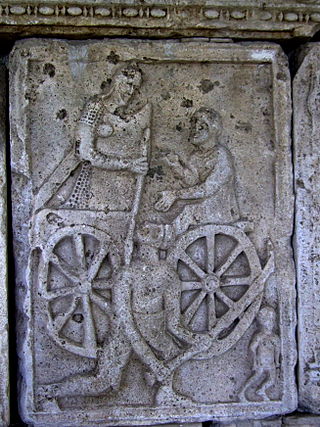
The rhomphaia was a close-combat bladed weapon used by the Thracians as early as 350-400 BC. Rhomphaias were weapons with a straight or slightly curved single-edged blade. Although the rhomphaia was similar to the falx, most archaeological evidence suggests that rhomphaias were forged with straight or slightly curved blades, presumably to enable their use as both a thrusting and slashing weapon. The blade was constructed of iron and used a triangular cross section to accommodate the single cutting edge with a tang of rectangular cross section. Length varied, but a typical rhomphaia would have a blade of approximately 60–80 cm (24–31 in) and a tang of approximately 50 cm (20 in). From the length of the tang, it can be presumed that, when attached to the hilt, this portion of the weapon would be of similar length to the blade.

The lorica squamata is a type of scale armour used by the ancient Roman military during the Roman Republic and at later periods. It was made from small metal scales sewn to a fabric backing. No examples of an entire lorica squamata have been found, but there have been several archaeological finds of fragments of such shirts and individual scales are quite common finds—even in non-military contexts.
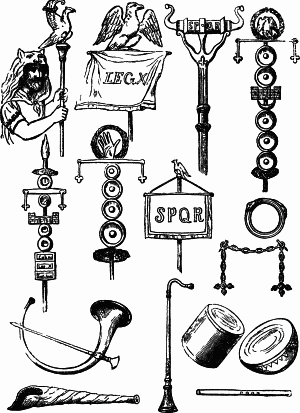
Roman military personal equipment was produced in large numbers to established patterns, and used in an established manner. These standard patterns and uses were called the res militaris or disciplina. Its regular practice during the Roman Republic and Roman Empire led to military excellence and victory. The equipment gave the Romans a very distinct advantage over their "barbarian" enemies, especially so in the case of armour. This does not mean that every Roman soldier had better equipment than the richer men among his opponents. Roman equipment was not of a better quality than that used by the majority of Rome's adversaries. Other historians and writers have stated that the Roman army's need for large quantities of "mass produced" equipment after the so-called "Marian Reforms" and subsequent civil wars led to a decline in the quality of Roman equipment compared to the earlier Republican era:
The production of these kinds of helmets of Italic tradition decreased in quality because of the demands of equipping huge armies, especially during civil wars...The bad quality of these helmets is recorded by the sources describing how sometimes they were covered by wicker protections, like those of Pompeius' soldiers during the siege of Dyrrachium in 48 BC, which were seriously damaged by the missiles of Caesar's slingers and archers.
It would appear that armour quality suffered at times when mass production methods were being used to meet the increased demand which was very high the reduced size cuirasses would also have been quicker and cheaper to produce, which may have been a deciding factor at times of financial crisis, or where large bodies of men were required to be mobilized at short notice, possibly reflected in the poor-quality, mass produced iron helmets of Imperial Italic type C, as found, for example, in the River Po at Cremona, associated with the Civil Wars of AD 69 AD; Russell Robinson, 1975, 67
Up until then, the quality of helmets had been fairly consistent and the bowls well decorated and finished. However, after the Marian Reforms, with their resultant influx of the poorest citizens into the army, there must inevitably have been a massive demand for cheaper equipment, a situation which can only have been exacerbated by the Civil Wars...

A shotel is a curved sword originating in Eritrea and northern Ethiopia. The curve on the blade varies from the Persian shamshir, adopting an almost semicircular shape. The blade is flat and double-edged with a diamond cross-section. The blade is about 40 inches (1 m) in total length and the hilt is a simple wooden or rhinoceros horn piece with no guard similar to the jile or jambiya. The shotel was carried in a close fitting leather scabbard which was often decorated in precious metals and worn on the right side.

Trajan's First Dacian War took place from 101 to 102.

Trajan's Second Dacian War was fought between 105 and 106 because the Dacian king, Decebalus, had broken his peace terms with the Roman Emperor Trajan from the Trajan's First Dacian War.

The Thraex, or Thracian, was a type of Roman gladiator armed in Thracian style. His equipment included a parmula, a small shield that might be rectangular, square or circular; and a sica, a short sword with a curved blade like a small version of the Dacian falx, intended to maim an opponent's unarmoured back. His other armour included greaves, a protective belt above a loincloth, and a helmet with a side plume, visor and high crest.

The sica is a short sword or large dagger of ancient Illyrians, Thracians, and Dacians; it was also used in ancient Rome. It is a shorter form of the falx, and the root of the word is the same as the modern sickle.

Tiberius Claudius Maximus was a cavalryman in the Imperial Roman army who served in the Roman legions and Auxilia under the emperors Domitian and Trajan in the period AD 85–117. He is noted for presenting Trajan with the head of Dacian king Decebalus, who had committed suicide after being surrounded by Roman cavalry at the end of Dacian Wars.
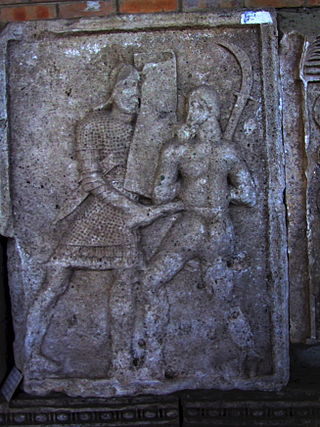
The history of Dacian warfare spans from c. 10th century BC to 2nd century AD in the region defined by Ancient Greek and Latin historians as Dacia, populated by a collection of Thracian, Ionian, and Dorian tribes. It concerns the armed conflicts of the Dacian tribes and their kingdoms in the Balkans. Apart from conflicts between Dacians and neighboring nations and tribes, numerous wars were recorded among Dacians too.

The scythe sword (Sensenschwert) was a type of single-edged sword of the German Renaissance, related to the Dussack. It consisted of the blade of a scythe to which a sword hilt was attached. Like the falx or falcata of antiquity, it was thus a curved sword with the cutting edge on the inside.